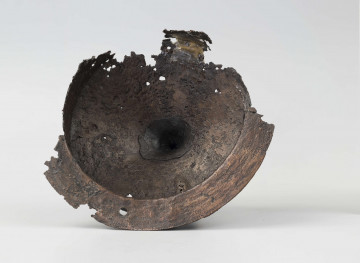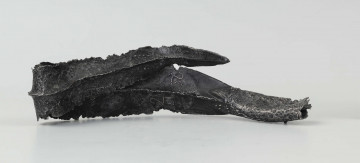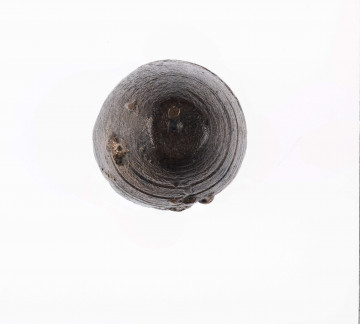
Umbo (shield boss)
201 — 210
National Museum in Lublin
Part of the collection: Archaeological monuments of the Lublin region
The ritually bent iron javelin spearhead is one of four preserved elements of a pole weapon discovered by chance in 1959 in Podlodowo, in a cremation grave dating to the early 3rd century AD. The discovery of the grave was made during agricultural works. In 1960 the found relics were transferred to the Voivdship Heritage Protection Officer in Lublin, and then to the Lublin Museum.
The grave gifts included: an iron sword with a copper inlay depicting the Roman gods: Mars and Victoria, a copper umbo (top part of a shield) with a high blunt spike, two iron spurs, two iron javelin spearheads ritually bent and broken, a tok (probably a spear shaft fitting), and a bent iron spearhead with a silver inlay on the leaf and sleeve in the form of symbolic signs and lines.
The javelin spearhead is one of two nearly identical examples of a laurel-leaved spearhead with a prominent rib in the centre and a short sleeve. The spearhead, identified with the weapon described by Tacitus in Germania as a framea, was ritually destroyed.
Weapons placed in the graves of warriors underwent various procedures, including burning at the stake with the remains of the deceased, and ritual destruction after being removed from the stake. Hardened iron was then easily bent.
A deformed spearhead was placed in the grave of a warrior of the Przeworsk culture. The weapon was used as a throwing weapon in battle by a mounted warrior, i.e. one belonging to the military elite of the time.
Author / creator
Dimensions
cały obiekt: height: 21,5 cm
Object type
weapon
Technique
forging
Material
iron
Creation time / dating
Creation / finding place
Owner
The National Museum in Lublin
Identification number
Location / status

201 — 210
National Museum in Lublin

201 — 210
National Museum in Lublin

201 — 210
National Museum in Lublin
DISCOVER this TOPIC
Museum of King Jan III's Palace at Wilanów
DISCOVER this PATH
Educational path